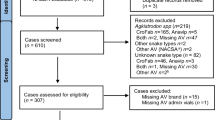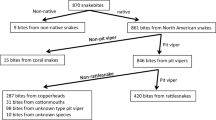Abstract
Introduction
Scorpion envenomation is potentially life-threatening and affects children in the Southwestern USA. An FDA-approved antivenom is available, but its high cost has led to use of off-label antivenom dosing or supportive care alone as alternatives to FDA-recommended dosing. This study sought to determine whether treatment approach influences outcomes in envenomated children.
Methods
A retrospective cohort study of children with grade III or IV scorpion envenomation evaluated in Phoenix Children’s Hospital ED between September 1, 2011, and March 31, 2014. Patients were grouped based on treatment: group 1, supportive care only; group 2, FDA-recommended dosing (3-vial initial dose); group 3, “off label” dosing (1–2 vial initial dose). Primary outcomes were ED length of stay and hospital admission. Secondary outcomes were mechanical ventilation and aspiration pneumonia.
Results
One hundred fifty-six patients were included with 58 patients in group 1, 16 patients in group 2, and 82 patients in group 3. Group 1 was significantly older than the antivenom groups (p < 0.001), and group 2 was younger than group 3 (p = 0.024). Envenomation grade was also different, with group 1 having fewer grade IV then groups 2 and 3 (p < 0.001). Three percent of group 1, 56 % of group 2, and 28 % of group 3 had respiratory distress (p < 0.001). ED LOS was not significantly different between groups. Hospital admission occurred in 3.4 % group 1, no group 2, and 8.5 % group 3 patients. Two intubations and two aspirations occurred in group 3.
Conclusions
In this study, clinical presentation appeared to influence treatment. Groups that received antivenom had a higher envenomation grade than the group that received supportive care. The FDA-recommended dosing group was younger and had more respiratory distress than those treated with initial doses of 1–2 vials. Outcomes were not significantly different between groups. Prospective studies may identify the ideal population for each treatment approach.
Similar content being viewed by others
References
LoVecchio F, McBride C. Scorpion envenomations in young children in Central Arizona. J Toxicol Clin Toxicol. 2003;41(7):937–40.
Curry SC, Vance MV, Ryan PJ, Kunkel DB, Northey WT. Envenomation by the scorpion Centruroides sculpturatus. J Toxicol Clin Toxicol. 1983-1984;21(4–5):417–49.
Skolnik AB, Ewald MB. Pediatric scorpion envenomation in the United States: morbidity, mortality, and therapeutic innovations. Pediatr Emerg Care. 2013;29(1):98–103.
US Food and Drug Administration: Anascorp® package insert. Available at http://www.fda.gov/downloads/BiologicsBloodVaccines/BloodBloodProducts/ApprovedProducts/LicensedProductsBLAs/FractionatedPlasmaProducts/UCM266725.pdf
Boyer LV, Theodorou AA, Berg RA, Mallie J. Antivenom for critically ill children with neurotoxicity from scorpion stings. N Engl J Med. 2009;360:2090–8.
Boyer L, Degan J, Ruha AM, et al. Safety of intravenous equine F(ab’)2: insights following clinical trials involving 1534 recipients of scorpion antivenom. Toxicon. 2013;76:386–93.
O’Connor A, Ruha AM. Clinical course of bark scorpion envenomation managed without antivenom. J Med Toxicol. 2012;8(3):258–62.
Gibly R, Williams M, Walter FG, McNally J, Conroy C, Berg RA. Continuous intravenous midazolam infusion for Centruroides exilicauda scorpion envenomation. Ann Emerg Med. 1999;34(5):620–5.
Armstrong EP, Bakall M, Skrepnek GH, Boyer LV. Is scorpion antivenom cost-effective as marketed in the United States? Toxicon. 2013;76:394–8.
Bond GR. Antivenin administration for Centruroides scorpion sting: risks and benefits. Ann Emerg Med. 1992;21(7):788–91.
Riley BD, LoVecchio F, Pizon AF. Lack of scorpion antivenom leads to increased pediatric ICU admissions. Ann Emerg Med. 2006;47(4):398–9.
Author information
Authors and Affiliations
Corresponding author
Ethics declarations
Conflicts of Interest
None of the authors have any conflicting financial relationships to declare.
Sources of Funding
There was no funding provided for this study.
Additional information
This study was presented as a platform at the American College of Medical Toxicology Annual Scientific Meeting in Clearwater, Florida, in March of 2015.
Rights and permissions
About this article
Cite this article
Coorg, V., Levitan, R.D., Gerkin, R.D. et al. Clinical Presentation and Outcomes Associated with Different Treatment Modalities for Pediatric Bark Scorpion Envenomation. J. Med. Toxicol. 13, 66–70 (2017). https://doi.org/10.1007/s13181-016-0575-3
Received:
Revised:
Accepted:
Published:
Issue Date:
DOI: https://doi.org/10.1007/s13181-016-0575-3




